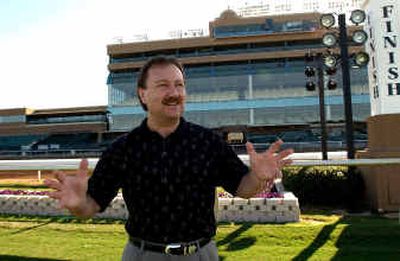Plans as big as Texas

GRAND PRAIRIE, Texas — The world championships of thoroughbred racing are being held this weekend at one of the smallest tracks in the event’s 21-year history and by far the newest. The host site is in an area not known for high-stakes racing and, thus, is rarely used by the sport’s elite.
Those are all reasons why Breeders’ Cup president D.G. Van Clief is thrilled to be at Lone Star Park.
“Our original mission was to build awareness and promote the well-being of the sport,” he said. “So obtaining a high profile in major marketplaces like Dallas-Fort Worth fits into our mission.”
And hosting the Breeders’ Cup fits the mission of Lone Star Park, too.
Track officials began dreaming about hosting this event since they conceived the place nine years ago. The day funding was finalized, Lone Star president Corey Johnson symbolized his goal by taking his keys off the rabbit’s foot he’d been carrying around and clipping them onto a key chain with the Breeders’ Cup logo.
As the track was being built, Cup officials were consulted to make sure it would meet their standards. Then, once Lone Star was up and running, Johnson and Charles England, the mayor of this suburb, pursued Van Clief so vigorously that he jokingly referred to them as his stalkers.
In its brief history, Lone Star’s largest crowd has been around 30,000 and the biggest purse for a thoroughbred race was $500,000. Saturday’s eight races will each pay between $1 million and $4 million and 51,000 fans will come out to see horse racing’s equivalent of having the eight best college football bowl games in one place at one time.
“We have proven within the industry that we are a progressive track. That’s why we got the event,” said Johnson, the track’s first employee. “What this does is give us a chance to reach more people. Now, when our card goes into France, people will say, ‘Oh yeah, I know that place. That’s where the Breeders’ Cup was.’ “
Many elite owners, breeders, trainers, riders and high-roller bettors from around the globe will be making their first trip to Lone Star, located about halfway between downtown Dallas and The Ballpark in Arlington, home of the Texas Rangers.
Some of them barely knew the place existed until it was awarded the Cup.
It’s surprising that horse racing in Texas is a foreign concept considering the popular, Hollywood-driven notion that everyone in the state rides horses and the reality that many of the top stables are owned by Texans.
Problem was, state law banned pari-mutuel wagering until 1987. Then the first two major tracks, in Houston and San Antonio, were beset by problems.
Lone Star proved to be different because of stronger ownership, better management and bigger dreams. A successful Cup could be the first step toward making Lone Star a more important track on the national circuit.
“We’re very fortunate,” Johnson said. “A lot of things have landed just right for us. I’ve been pleasantly surprised by the support we’ve received from the industry. It’s almost as if people were rooting for us. They appreciated what we had done for the sport in opening up the north Texas market in a successful manner.”
The Breeders’ Cup first went to a smaller track in 1989 at Gulfstream Park in Florida. It first went to a nontraditional market in 1996 by going to Woodbine in Toronto. The Cup was at Arlington Park outside Chicago two years ago and is headed to Monmouth Park along the New Jersey shore in three years.
Lone Star was just a blueprint and a vacant field when Johnson first told Van Clief he wanted to bring the Breeders’ Cup to Texas, but Van Clief knew him well enough to take him seriously.
Cup officials toured the facility a few years after it opened and left convinced it was worthy of the big event. So Johnson began turning ideas into a plan.
He met with a temporary seating company and ordered an economic feasibility survey. The numbers showed so much benefit for the area that he began lobbying state government to give back some of the money it collects from Lone Star, with the promise of using it to pay for the temporary seats.
When the state approved the rebate the following summer, Van Clief requested a formal bid and was approved soon after.
Lone Star has spent nearly $9 million getting ready.
Because the track is so new, the permanent changes are things like expanding the stable area, adding a huge party room with a balcony overlooking the finish line and replacing frontside benches with individual seats. The temporary additions include 39,000 seats and 71 corporate suites.
Tickets cost between $25 and $125 and sold out quickly. There are no general admission seats because officials wanted to know exactly where fans would be sitting, so there would be enough betting windows, concession stands and toilets.
Only six of the 101 horses entered in the Cup races have run at Lone Star, so many owners were understandably concerned about the dirt and turf courses. Foreign owners who attended yearling sales in Kentucky last month even made side trips to Texas for firsthand inspections.
“We’re getting high marks,” Van Clief said.
Van Clief arrived last week and after looking around said he’s as confident as he’s ever been at a first-time Cup site. He’s looking forward to an exciting day of races capped by the inevitable question: Are you coming back?
“Even if the answer is yes,” he said, laughing, “Corey may not want us until 2018.”